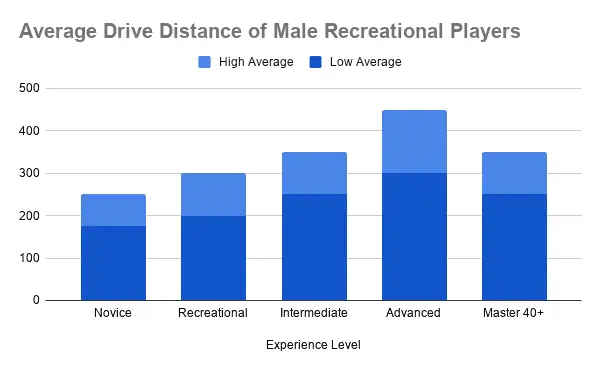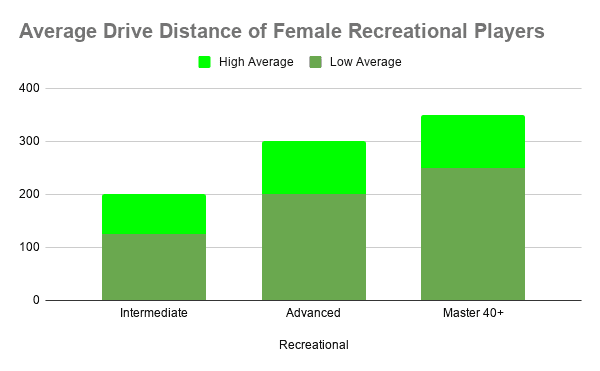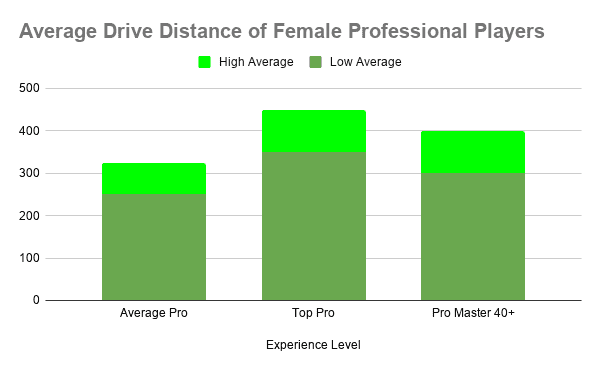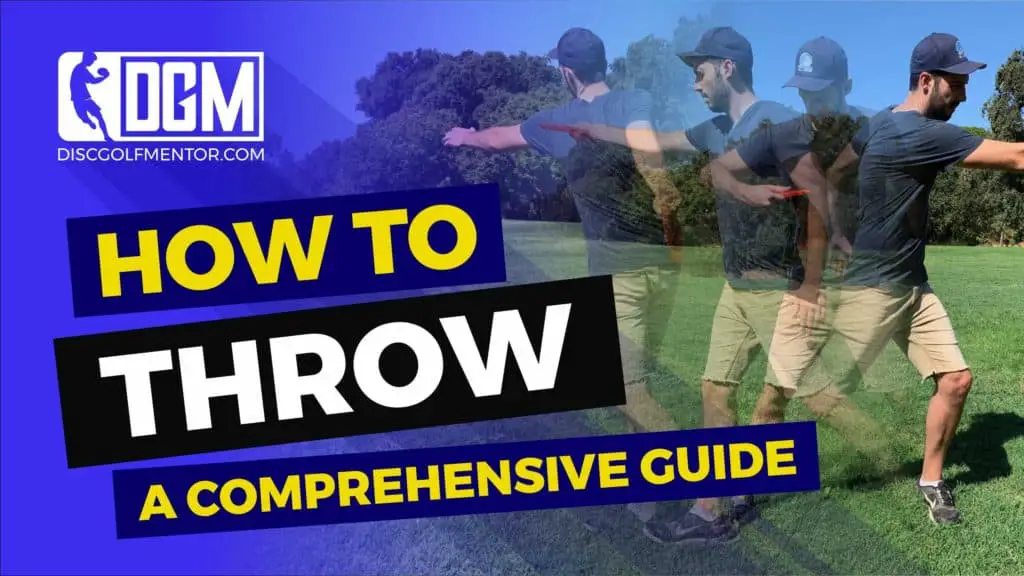If you’re just starting out in disc golf, you may be wondering how your drive distance compares to the drive distance of a typical player. To determine how you stack up, it will be helpful to know the average drive distance in disc golf.
According to the PDGA the average drive distance in disc golf for a recreational player is between 200 and 300 feet. That’s for someone who has been playing for 1 to 2 years. The average drive distance for a novice player who is just getting into the sport is 175 to 250 feet.
Average disc golf drive distances are broken down based on several factors. There are different averages to expect depending on your level of experience, gender and age.
Average Disk Golf Drive Distances
It is important to account for different factors when you’re comparing your own drive distance to average drive distances. As you play more and gain experience, your technique will improve and you will be able to drive farther. There is also your level of fitness and strength. Typically, men can drive farther than women. Also, driving distance generally decreases as players age. Average disc golf driving distances for amateur players based on their level of experience and gender are shown in the table below.
Recreational Player Drive Distance
| Experience Level | Male Players (Average Drive Distance) | Female Players (Average Drive Distance) |
| NOVICE (players who are still learning the sport) | 175-250 feet | Not Available |
| RECREATIONAL (players with 1 to 2 years of experience) | 200-300 feet | Not Available |
| INTERMEDIATE (players with 2 to 3 years of experience) 250 | 250-350 feet | 125-200 feet |
| ADVANCED (players with several years experience and tournament experience) | 300-450 feet | 200-300 feet |
| MASTER 40+ (players who are 40 or older, with several years experience and seasoned tournament experience)250-350 feet250-350 feet |


For some categories, such as novice female players, there is no average provided because there is so much variability in players’ abilities. Similarly, there are no averages for categories of players who are 50 years of age or older.
Professional players have years of experience and have spent countless hours training. Their average disc golf drive distances are impressive not only because of how far they can drive but because they can hit those distances consistently. Average disc golf driving distances for professional players based on their level of experience and gender are shown in the table below.
Professional Player Drive Distance
| Professional Level | Male Players(Average Drive Distance) | Female Players(Average Drive Distance) |
| AVERAGE PLAYER (players with several years of tournament experience) | 325-400 feet | 250-325 feet |
| TOP PLAYER (players with many years of tournament experience) | 350-600+ feet | 300-450+ feet |
| PRO MASTER 40+ (players who are 40 or older, with many years of experience and seasoned tournament experience) | 300-400 feet | 300-400 feet |


It is important to remember that there is a lot more to disc golf than just driving. If you are trying to determine how you rank in the scale of novice to top professional you will also have to consider other factors like whether you can throw consistently, if you have different types of throws and how well you can putt. While it may be tempting to compare yourself to others, especially when you’re starting out, remember that the important thing is to focus on technique and not to ignore all the other skills involved in the sport.
What Affects Drive Distance
We have already touched on the characteristics of the player that might affect drive distance, such as age, gender and level of experience but there are several other factors that can affect a drive’s distance. This includes weather conditions and terrain
You may have a great drive in perfect conditions like flat ground on a calm day. The bigger test comes when your environment makes things difficult. Wind can be a major factor. On a calm day, it may not bother you but strong winds will have a tremendous impact on your drive. Having the wind at your back is great for getting an added boost to your drives. If you have to drive against the wind you will struggle a lot more to get a good distance.
Rain can also be a problem. Rain can push down on the disc and create more friction. This will decrease the distance of a drive. You may not notice much of a difference in light rain. If you try sticking out a heavy downpour to play a round, you’ll notice a massive impact on your drive distance. Even humidity levels could make difference. The current distance record was set in the dry Nevada desert.
Terrain can also make a big difference. Terrain is the physical features of the course. If you are at the top of a hill, your drive will go a lot farther than on flat ground. This is because as the disc moves forward, there is a greater distance between the disc and the ground so the disc will travel a greater distance before landing. Similarly, if you are driving up a slope you won’t be able to drive as far as you normally would because the space between the disc and the ground decreases much more quickly.
There is also the challenge of obstacles. There may be a stand of trees or a pond that prevents you from driving in a straight line towards the basket. In this case, you may need to drive a shorter distance and take more throws to get around the obstacle or drive the disc so that it travels around the obstacle if you can. Either way, this will reduce how far your drive goes.
Power Grip Breakdown
I’ve done a breakdown of all the grips in this guide, and they’re all free to watch. Use the link below to get to all the videos.
What Discs to Use for Driving
My favorite distance drivers can be found here: Understable Drivers, Stable Drivers & Overstable Drivers.
When driving, it is important to have the right tool for the job. Having a good driving disc will make a big difference. In disc golf, the best type of disc to use for driving is called a driver. Drivers go farther than other discs because of their design. They tend to have wider rims and are the flattest type. They can be a little trickier for beginners to use because you need the right technique to keep them flying straight.
There are two types of drivers: distance drivers and fairway drivers. Distance drivers are designed to go the farthest distance. They are what you would normally use from the tee. Because they are designed for distance, they may be more difficult to control. For experienced players, distance drivers are the best kind of disc for getting the most distance.
Fairway drivers are intended to travel far and they are designed to be more stable. They are used for shots that require distance and more accuracy. A drawback of that added stability is that they typically cannot travel as far as distance drivers. Fairway drivers are great for beginners because of their speed and stability. Beginners likely don’t have the arm speed to handle a high speed distance driver, and will usually get better distance out of a lower speed disc.
There are a lot of variations of driver discs available. Designs differ in terms of diameter, rim width, stability, flatness and weight. There is also a variety of different plastics that discs can be made of. These variations help to overcome course and environmental conditions. For example, there are some that are designed to cut through wind, some are designed to glide farther for players who have a less powerful throw and some are designed to travel left or right to help get around obstacles.
While drivers are designed to go farther than other types of disc, there is no one driver that is best. There are a lot of different kinds and each player will have their own preference. There are also different drivers for different situations like a distance driver versus a fairway driver. If you want to learn more about discs, check out my gear recommendations.
Longest Disc Golf Drive Records
The longest disc golf drive distance record is 1,108.9 feet and was thrown by David Wiggins Jr. according to the World Flying Disc Federation. The female record holder is Jennifer Allen who threw 568.6 feet, which was also outdoors. These drives were thrown outdoors and on flat terrain. With outdoor drives, environmental factors can make a big difference. Notably, a strong wind can help carry a disc a lot farther. As such, it can be difficult to fairly compare outdoor drive distance records.
Indoor records provide a level playing field. With an indoor environment players are able to compare their drives under the same conditions, so something like wind wouldn’t be such a big factor. The current indoor record is held by Dan Berman with a 471 feet drive. The female record holder is Chris O’Cleary who hit 315.8 feet. The challenge is that because of the lack of indoor spaces large enough to try to establish distance records, fewer competitors have the opportunity to set indoor records.
Now that you know how you stack up against the pros, you may be wondering how you compare to other species. The record for longest drive distance by a non-human is 32 feet. This record was set by Alex a sea lion at the St. Louis zoo.
The world record drive disc thrown by David Wiggins Jr. was a Boss by Innova Discs. It is a lightweight disc that combines an overstable design with an understable plastic called R-Pro. It has a 2.5cm rim, which is the widest allowed by the PDGA. Jennifer Allen set her record with a Wraith by Innova Discs made of the StarLite plastic. The Wraith is similar in design to the Boss, but is slightly lighter and with a narrower rim (2.1cm) to better suit Allen’s throwing style. Unfortunately, there is no record of what disc Alex the sea lion used to set his record.
Other Important Driving Metrics
Another important thing to consider is that different types of shots fly differently. For instance, a spike hyzer will never go as far as a hyzer flip shot. Their just designed to do different things. So keep in mind what type of shot you’re throwing and if you’re throwing it the right way and with the right disc.
For a great list of the different types of shots and how to throw them, you can check out this article here.
Form Makes All the Difference
Driving in disc golf is most commonly done with a backhand throw using a distance or fairway driver. It’s quite common to also see a forehand drive style off the tee. Typically, driving also involves a run up which is the footwork a player uses to build momentum and generate kinetic energy.
For in depth information on how to throw the different driving styles and the footwork needed, I strongly recommend heading over to my How To Throw guide. Everything is broken down into individual steps with pictures.
How To Drive Farther?
The main way to drive farther is by improving your technique. It may be helpful to get a more experienced player to watch your drive and give you some tips. Again, head over to my guide on How To Throw for a breakdown of the correct form.
You may also be able to get more distance using a different disc. It could be that the disc you’re throwing is actually meant for a higher arm speed. I recommend that you “disc down” which means to try a disc with a lower speed rating. It could be that your arm is better suited for a lower speed rating, in which case, the disc will actually go further than the high speed disc will for your arm.

